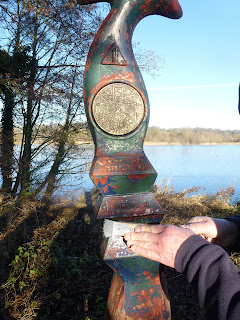 |
| Mandarin drake. |
A
perfect winter’s day: a crisp frost, to harden muddy paths, with sun coming
through to warm Honeyguiders. From the car park at Whitlingham Country Park we
could see that the lone shag, here in this unusual inland setting since 3 January,
was in its usual resting place on the pontoon floating in Whitlingham Great
Broad. |
| Whitlingham Woods. |
 |
| Winter sunshine (Ann Greenizan). |
However,
we set off in a slightly different direction, through the picnic meadow and into
Whitlingham Woods. On a January day, enjoying a walk in the sunshine was rewarding
enough, though there was wildlife to steady and identify. A pile of very big logs
was a good place to see fungi. Turkeytail was abundant; the biggest fungi were
chunky southern brackets; also here were hairy curtain crust and the emerging
yellow tips of some yellow stagshorn. |
| Southern bracket. |
 |
| Turkeytail. |
A
little further along, Ann was alert to some yellow brain fungi; this parasitic
and distinctive species is always nice to see. By it were pale globules of
crystal brain fungi, too.
 |
| Yellow brain fungus. |
 |
| Crystal brain fungus. |
In
the sunshine, we noted the hint of purple on alder catkins. In Whitlingham
Lane car park, the big rosettes of hoary mullein were paler than ever covered by
frost. Then a bank we scanned had hundreds of emerging snowdrops in bud.
 |
| A frosty hoary mullein rosette: it's a flower that is special to East Anglia so features in Norfolk's Wonderful 150. |
Up
the slope in the woods we paused to look at a large clump of spurge laurel, a
daphne, with flower buds. Then we found some flowering red campion, in that
case hanging on from the mild autumn rather than early-season blooms, and many
male and hart’s-tongue ferns. Birds were what you might expect: mostly tits and
robins, the trill of a wren.
 |
| Spurge laurel. |
Back
at the car park we picked up the telescope, though that was far from needed
for the ducks and geese that had gathered where they are fed. Along with the
semi-domestic mallards, mute swans, greylag and Egyptian geese were three
Whitlingham regulars: barnacle goose, hybrid greylag x Chinese goose (aka
domestic swan goose) and a male mandarin duck. The mandarin is, in my experience, more often absent than present, so to see it well today was
quite a bonus.
 |
| In the repair shop today ... a millennium sculpture. |
A
short way along our clockwise circuit of the broad, two men had just started
work to renovate a sculpture installed to mark the millennium, in connection
with the cycle network.
We
shared the path with walkers, joggers, families and all sorts, but that doesn’t
seem to trouble the birds here. A Cetti’s warbler sang. Tufted ducks were the
commonest ducks on the broad, gadwall the second commonest. Farther round we
also saw teals and drake pochards, though failed to find the goldeneyes that another
birdwatcher mentioned.
 |
| Siskins, if you look carefully. |
Siskins
were calling and were still enough in a tall alder to see splashes of yellow on
them through the telescope. Then we overlooked Thorpe Marshes and headed back
towards the car park. There were many cormorants and a heron though the best
bird was the shag again, back on the pontoon. At first it was perching on one
leg, before confirming it had two legs as it dashed to see off a cormorant that
swam close to the pontoon.
 |
| Shag - same bird, different views. |
The
sun was still shining as we finished our visit to Whitlingham with coffee and
scones at the barn café.
Chris
Durdin
















No comments:
Post a Comment